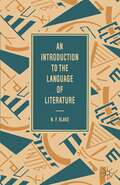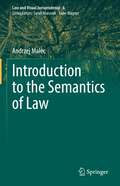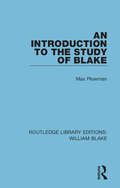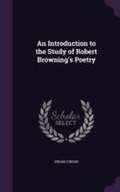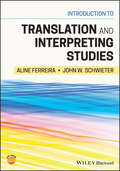- Table View
- List View
An Introduction to the French Poets: Villon to the Present Day (Routledge Revivals)
by Geoffrey BreretonThe French poetry of some five centuries is here surveyed in a series of studies of the work and personality of individual poets from Villon to the present day. Each chapter is primarily concerned with establishing the ‘literary identity’ of the poet or poets with whom it deals: the work of each is outlined and related to the historical and biographical circumstances in which it was written; and its characteristics are then examined critically in terms relevant to the modern reader. Comparisons are made between different poets, and more general topics – such as the concepts of ‘classic’ and ‘baroque’ – are discussed. This book, first published in 1956, had become a standard introductory work for students of French poetry and general readers alike. For this revised edition, originally published in 1973, new chapters have been added on ‘irregular’ seventeenth-century poets and on various modern poets whose work now enables the Surrealist movement to be seen in clearer perspective. The bibliography has been revised extensively.
An Introduction to the French Poets: Villon to the Present Day (Routledge Revivals)
by Geoffrey BreretonThe French poetry of some five centuries is here surveyed in a series of studies of the work and personality of individual poets from Villon to the present day. Each chapter is primarily concerned with establishing the ‘literary identity’ of the poet or poets with whom it deals: the work of each is outlined and related to the historical and biographical circumstances in which it was written; and its characteristics are then examined critically in terms relevant to the modern reader. Comparisons are made between different poets, and more general topics – such as the concepts of ‘classic’ and ‘baroque’ – are discussed. This book, first published in 1956, had become a standard introductory work for students of French poetry and general readers alike. For this revised edition, originally published in 1973, new chapters have been added on ‘irregular’ seventeenth-century poets and on various modern poets whose work now enables the Surrealist movement to be seen in clearer perspective. The bibliography has been revised extensively.
An Introduction to The Gawain-Poet
by Ad PutterThe late 14th century produced a crop of brilliant writers: Chaucer, Langland and Gower. Their achievement was rivalled only by a series of four works generally agreed to have been written by a single northern author, known as the Gawain-Poet. This book introduces the reader to the Gawain-poet's four surviving works: Sir Gawain and the Green Knight, Patience, Pearl and Cleanness. The four poems are made accessible to the student by setting them in their relevant historical and cultural context and by developing some lines of critical argument. All studies are based on the author's own research and translations.
An Introduction to The Gawain-Poet
by Ad PutterThe late 14th century produced a crop of brilliant writers: Chaucer, Langland and Gower. Their achievement was rivalled only by a series of four works generally agreed to have been written by a single northern author, known as the Gawain-Poet. This book introduces the reader to the Gawain-poet's four surviving works: Sir Gawain and the Green Knight, Patience, Pearl and Cleanness. The four poems are made accessible to the student by setting them in their relevant historical and cultural context and by developing some lines of critical argument. All studies are based on the author's own research and translations.
An Introduction to the Language of Literature (The Language of Literature)
by Norman BlakeThis book presents an introduction to stylistics for students of literature. It does not presuppose linguistic knowledge, but it approaches literature in a linguistic way. In the first half it looks at the make-up of a sentence in English and how sentence elements are exploited by literary authors. In the second half it looks at the way in which a text is unified by elements beyond the sentence. The conclusion exemplifies the theory explained in the previous chapters.
An Introduction to the Languages of the World
by Brett Kessler Anatole Lyovin William LebenUnique in scope, An Introduction to the Languages of the World introduces linguistics students to the variety of world's languages. Students will gain familiarity with concepts such as sound change, lexical borrowing, diglossia, and language diffusion, and the rich variety of linguistic structure in word order, morphological types, grammatical relations, gender, inflection, and derivation. It offers the opportunity to explore structures of varying and fascinating languages even with no prior acquaintance. A chapter is devoted to each of the world's continents, with in-depth analyses of representative languages of Europe, Asia, Africa, Oceania, and America, and separate chapters cover writing systems and pidgins and creoles. Each chapter contains exercises and recommendations for further reading. New to this edition are eleven original maps as well as sections on sign languages and language death and revitalization. For greater readability, basic language facts are now organized in tables, and language samples follow international standards for phonetic transcription and word-by-word glossing. There is an instructor's manual available for registered instructors on the book's companion website.
An Introduction to the Languages of the World
by Anatole Lyovin Brett Kessler William LebenUnique in scope, An Introduction to the Languages of the World introduces linguistics students to the variety of world's languages. Students will gain familiarity with concepts such as sound change, lexical borrowing, diglossia, and language diffusion, and the rich variety of linguistic structure in word order, morphological types, grammatical relations, gender, inflection, and derivation. It offers the opportunity to explore structures of varying and fascinating languages even with no prior acquaintance. A chapter is devoted to each of the world's continents, with in-depth analyses of representative languages of Europe, Asia, Africa, Oceania, and America, and separate chapters cover writing systems and pidgins and creoles. Each chapter contains exercises and recommendations for further reading. New to this edition are eleven original maps as well as sections on sign languages and language death and revitalization. For greater readability, basic language facts are now organized in tables, and language samples follow international standards for phonetic transcription and word-by-word glossing. There is an instructor's manual available for registered instructors on the book's companion website.
An Introduction To The Philosophy Of Language (PDF)
by Michael MorrisIn this textbook, Michael Morris offers a critical introduction to the central issues of the philosophy of language. Each chapter focusses on one or two texts which have had a seminal influence on work in the subject, and uses these as a way of approaching both the central topics and the various traditions of dealing with them. Texts include classic writings by Frege, Russell, Kripke, Quine, Davidson, Austin, Grice and Wittgenstein. Theoretical jargon is kept to a minimum and is fully explained whenever it is introduced. The range of topics covered includes sense and reference, definite descriptions, proper names, natural-kind terms, de re and de dicto necessity, propositional attitudes, truth-theoretical approaches to meaning, radical interpretation, indeterminacy of translation, speech acts, intentional theories of meaning, and scepticism about meaning. The book will be invaluable to students and to all readers who are interested in the nature of linguistic meaning.
An Introduction to the Psychology of Language (Psychology Library Editions: Psycholinguistics)
by Peter HerriotOriginally published in 1970, this was Peter Herriot’s first book. In this objective, critical evaluation of a rapidly expanding field, Professor Herriot examines language as skilled behaviour, generative linguistics and psychology, behaviourist approaches to meaning, language acquisition and impairment, and language and thought. He stresses throughout the necessity for empirical research and for experimental verification of hypotheses; he also feels that language behaviour should be analysed in a comprehensive form, placing emphasis not only on structural aspects but also on the importance of meaning and context to any account of language. Today it can be read and enjoyed in its historical context.
An Introduction to the Psychology of Language (Psychology Library Editions: Psycholinguistics)
by Peter HerriotOriginally published in 1970, this was Peter Herriot’s first book. In this objective, critical evaluation of a rapidly expanding field, Professor Herriot examines language as skilled behaviour, generative linguistics and psychology, behaviourist approaches to meaning, language acquisition and impairment, and language and thought. He stresses throughout the necessity for empirical research and for experimental verification of hypotheses; he also feels that language behaviour should be analysed in a comprehensive form, placing emphasis not only on structural aspects but also on the importance of meaning and context to any account of language. Today it can be read and enjoyed in its historical context.
An Introduction to the Russian Novel (Routledge Revivals)
by Janko LavrinIn this book, first published in 1943, Janko Lavrin provides an overview of the development of the Russian novel by placing the great Russian novelists – Tolstoy, Dostoevsky, Turgenev, Gorky, Gogol – in relation to their native literature and their social, political and cultural backgrounds. An Introduction to the Russian Novel will appeal particularly to students of Russian literature and culture as well as those interested in the development of the novel in general.
An Introduction to the Russian Novel (Routledge Revivals)
by Janko LavrinIn this book, first published in 1943, Janko Lavrin provides an overview of the development of the Russian novel by placing the great Russian novelists – Tolstoy, Dostoevsky, Turgenev, Gorky, Gogol – in relation to their native literature and their social, political and cultural backgrounds. An Introduction to the Russian Novel will appeal particularly to students of Russian literature and culture as well as those interested in the development of the novel in general.
An Introduction to the Science of Deception and Lie Detection
by Chris N. StreetThis accessible book provides a foundational understanding of the science of deception and lie detection. Focusing on core issues for the field, it discusses classic and current psychological research into lying as well as theoretical approaches to understanding human lie detection. This book explores engaging questions around how people lie, how people make decisions about believing others, and how we can detect deception. Each chapter is clearly structured to support students of all levels by summarising content, presenting key research, and systematically evaluating findings. Chapters explore topics including some of the most promising current lie detection techniques, how and why people lie, how lying develops in children, and whether unconscious thinking can boost lie detection accuracy. Providing an overview of key issues in deception, this book will be of great interest to students and lecturers in the field of deception and lie detection, as well as anyone generally interested in this fascinating field of research.
An Introduction to the Science of Deception and Lie Detection
by Chris N. StreetThis accessible book provides a foundational understanding of the science of deception and lie detection. Focusing on core issues for the field, it discusses classic and current psychological research into lying as well as theoretical approaches to understanding human lie detection. This book explores engaging questions around how people lie, how people make decisions about believing others, and how we can detect deception. Each chapter is clearly structured to support students of all levels by summarising content, presenting key research, and systematically evaluating findings. Chapters explore topics including some of the most promising current lie detection techniques, how and why people lie, how lying develops in children, and whether unconscious thinking can boost lie detection accuracy. Providing an overview of key issues in deception, this book will be of great interest to students and lecturers in the field of deception and lie detection, as well as anyone generally interested in this fascinating field of research.
An Introduction to the Science of Phonetics
by Nigel Hewlett Janet Mackenzie BeckThe book is designed as an introduction to the scientific study of speech. No prior knowledge of phonetics is assumed. As far as mathematical knowlege is concerned, all that is assumed is a knowledge of simple arithmetic and as far as possible concepts are dealt with on an intuitive rather than mathematical level. The anatomical material is all fully explained and illustrated. The book is arranged in four parts. Part 1, Basic Principles, provides an introduction to established phonetic theory and to the principles of phonetic analysis and description, including phonetic transcription. Part 2, Acoustic Phonetics, considers the physical nature of speech sounds as they pass through the air between speaker and hearer. It includes sections on temporal measurement, fundamental frequency, spectra and spectrograms. Part 3, Auditory Phonetics, covers the anatomy of the ear and the perception of loudness, pitch and quality. The final part, Part 4, covers the articulatory production of speech, and shows how experimental techniques and tools can enhance our understanding of the complexities of speech production. Though the audience for this book is mainly students and professors in the Speech Sciences, it will also be valuable to any students studying hearing science and acoustics. The book is well supported with figures, tables, and practice boxes with experiments.
An Introduction to the Science of Phonetics
by Nigel Hewlett Janet Mackenzie BeckThe book is designed as an introduction to the scientific study of speech. No prior knowledge of phonetics is assumed. As far as mathematical knowlege is concerned, all that is assumed is a knowledge of simple arithmetic and as far as possible concepts are dealt with on an intuitive rather than mathematical level. The anatomical material is all fully explained and illustrated. The book is arranged in four parts. Part 1, Basic Principles, provides an introduction to established phonetic theory and to the principles of phonetic analysis and description, including phonetic transcription. Part 2, Acoustic Phonetics, considers the physical nature of speech sounds as they pass through the air between speaker and hearer. It includes sections on temporal measurement, fundamental frequency, spectra and spectrograms. Part 3, Auditory Phonetics, covers the anatomy of the ear and the perception of loudness, pitch and quality. The final part, Part 4, covers the articulatory production of speech, and shows how experimental techniques and tools can enhance our understanding of the complexities of speech production. Though the audience for this book is mainly students and professors in the Speech Sciences, it will also be valuable to any students studying hearing science and acoustics. The book is well supported with figures, tables, and practice boxes with experiments.
Introduction to the Semantics of Law (Law and Visual Jurisprudence #6)
by Andrzej MalecThis book offers an introduction to the language of law from the perspective of logical semantics. As a logical tool, Boguslaw Wolniewicz’s formal ontology of situations is adapted. The central issue addressed is the meaning of normative statements, primarily legal norms. The main outcome of the book consists in explications of several legal notions (including legal events, legal acts and legal rules) in terms of the formal ontology of situations. In addition, the book concludes that legal norms are sentences in a logical sense, so some are true, while others are false, and that their logical value does not depend on whether or not they were adopted in the law-making process. Lastly, the book contends that there are semantic relations between orders that are similar to entailment, contradiction, opposition, and sub-opposition, despite the fact that orders are not sentences in a logical sense, i.e., they are neither true nor false.The book also presents some original Wittgenstein-style deontic logics built on the first order logic. The formal results are applied to selected problems in the theory of law, including the problem of the possibility of algorithmic application of legal norms.
An Introduction to the Study of Blake (Routledge Library Editions: William Blake)
by Max PlowmanFirst published in 1927 (this edition in 1967), this book is about Blake, his symbols, and their meanings. As Ward says in his forward, the volume goes beyond Blake, becoming universal and timeless, and is about Religion. Plowman’s book presents itself, not as a critical text, but an interpretative one, and the study therefore illuminates the work of the author, as well as that of William Blake.
An Introduction to the Study of Blake (Routledge Library Editions: William Blake #5)
by Max PlowmanFirst published in 1927 (this edition in 1967), this book is about Blake, his symbols, and their meanings. As Ward says in his forward, the volume goes beyond Blake, becoming universal and timeless, and is about Religion. Plowman’s book presents itself, not as a critical text, but an interpretative one, and the study therefore illuminates the work of the author, as well as that of William Blake.
An Introduction to Transformational Syntax (Routledge Library Editions: Syntax #9)
by Roger FowlerTransformational syntax is an analytic technique of grammatical description which has exciting psychological and philosophical ramifications inspiring creative research into the conceptual powers and behaviour of man. In this book, first published in 1971, the author suggests that the techniques of the classical period (1964-66) of transformational syntax provide the securest foundation for syntactic analysis, and are indispensable if students are to understand recent changes to the analytical technique. This title will be of interest to students of language and linguistics.
An Introduction to Transformational Syntax (Routledge Library Editions: Syntax)
by Roger FowlerTransformational syntax is an analytic technique of grammatical description which has exciting psychological and philosophical ramifications inspiring creative research into the conceptual powers and behaviour of man. In this book, first published in 1971, the author suggests that the techniques of the classical period (1964-66) of transformational syntax provide the securest foundation for syntactic analysis, and are indispensable if students are to understand recent changes to the analytical technique. This title will be of interest to students of language and linguistics.
Introduction to Translation and Interpreting Studies
by Aline Ferreira John W. SchwieterA unique and balanced combination of translation and interpreting studies, edited and written by leading voices in the fields In Introduction to Translation and Interpreting Studies, accomplished scholars Aline Ferreira and John W. Schwieter have brought together a detailed and comprehensive introductory-level textbook covering the essential aspects of translation and interpreting studies. Through chapters authored by leading voices in the field, this book covers topics of theoretical and conceptual relevance—such as the history of the development of the field and methods for understanding gender, society, and culture as aspects of the role of the interpreter—as well as critical topics in the application of theory to real world practice. Beginning with an authoritative treatment of the theoretical developments that have defined the field since the early 1970s, this textbook first describes the influential work of such figures as Jakobson, Holmes, and Toury, thus ensuring students develop a thorough understanding of the history and theoretical underpinnings of the fields of translation and interpreting studies. The text then begins to introduce grounded discussions of interpreting in specialized fields such as legal and healthcare interpreting and sign language translation. Learning is reinforced throughout the text through pedagogical features including reflection questions, highlighted key words, further readings, and chapter objectives. Instructors will also have access to companion website with PowerPoint slides and multiple-choice questions to support classroom application. Truly a unique work in translation and interpreting studies, this essential new textbook offers: A thorough introduction to the fields of translation and interpreting with discussion of applications to interdisciplinary topics Explorations of translation machines and technology, including their history and recent trends Practical discussions of culture, gender, and society in the context of translation and interpreting studies, as well as training and pedagogical issues in translation and interpreting A concise examination of translation process research and methods, including the mental processes and actions that people take while translating Complementary web materials including PowerPoint slides and practice questionsIdeal for advanced undergraduate and graduate students in programs in such as linguistics, language studies, and communications, or for those who plan to work in translation and/or interpreting, Introduction to Translation and Interpreting Studies will earn a place in the libraries of anyone interested in a reader-friendly translation and interpreting resource.



